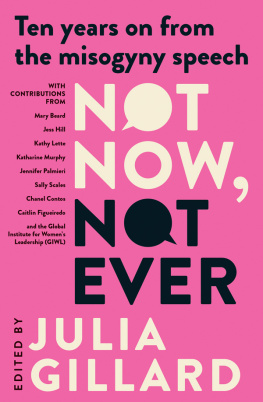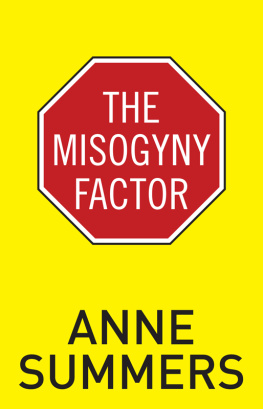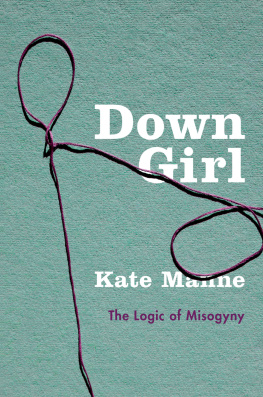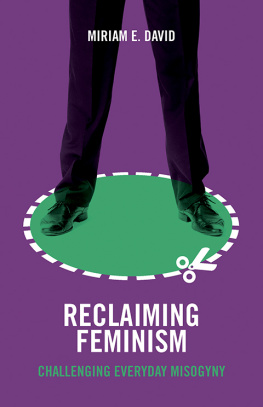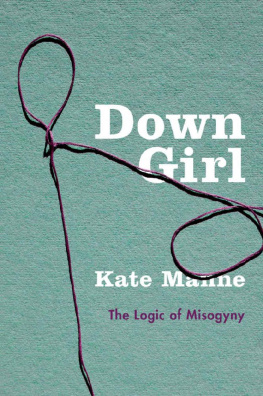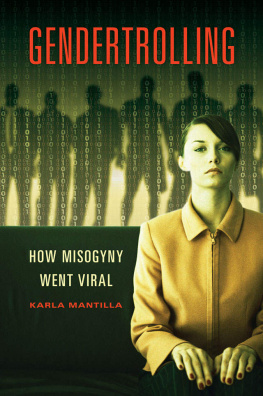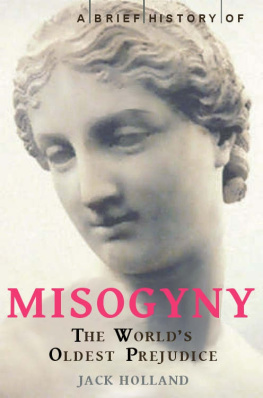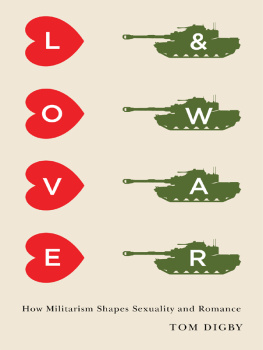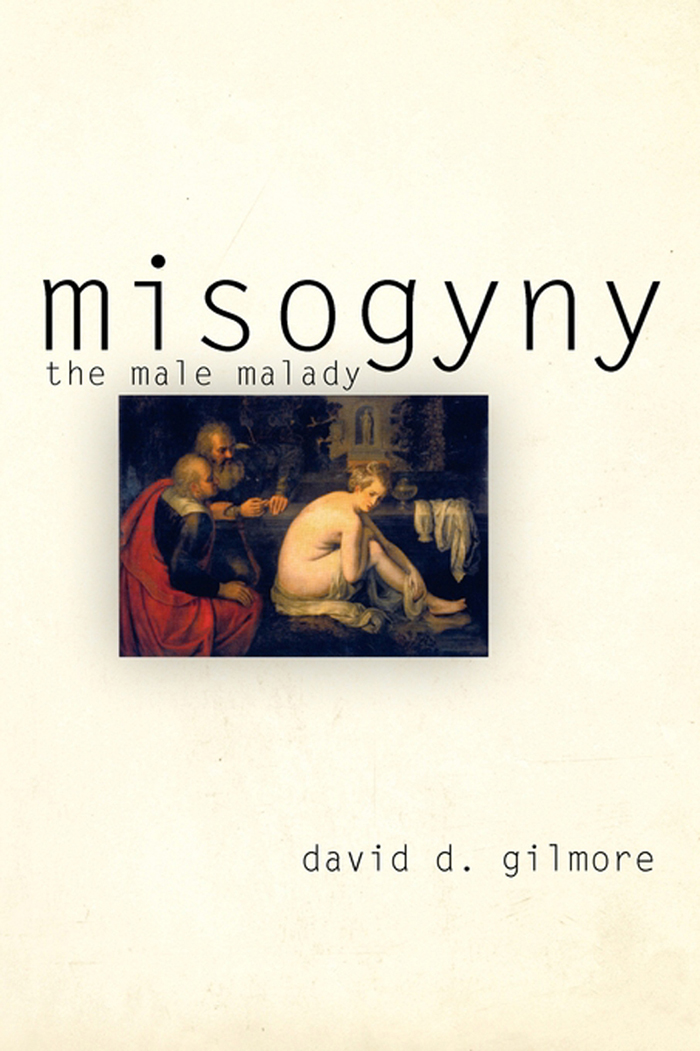misogyny
misogyny
the male malady
david d. gilmore
PENN
university of pennsylvania press
philadelphia
Copyright 2001 University of Pennsylvania Press
All rights reserved
Printed in the United States of America on acid-free paper
10 9 8 7 6 5 4 3 2 1
Published by
University of Pennsylvania Press
Philadelphia, Pennsylvania 19104-4011
Library of Congress Cataloging-in-Publication Data
Gilmore, David D., 1943
Misogyny : the male malady / David Gilmore.
p. cm.
Includes bibliographical references and index.
ISBN 0-8122-3589-4 (cloth : alk. paper)
1. Misogyny. I. Title.
HQ1233 .G55 2001
305.42dc21 2001027131
To Aggie and Julian
Contents
God became man, granted. The devil became a woman.
Victor Hugo, Ruy Blas
Woman to man
Is either a god or a wolf.
John Webster, The Duchess of Malfi
Mans imaginative recognition of feminine charm, mans greedy lust, mans pride in possession, mans tremulous sense of the pathos of femininity, mans awe in the presence of an abysmal mysteryall these feelings exist in a curious detachment in his consciousness.
John Cowper Powys, A Glastonbury Romance
Preface
Since I am a man writing a book about mans inhumanity toward woman, I feel I should explain my motives, if only by way of exculpation. Like most baby-boom males, I consider myself a tolerant and enlightened man, and I harbor a sincere fondness for women as friends, lovers, colleagues, workmates, and, of course, paragons of physical beauty. However, I do recognize occasional negative stirrings in myself, feelings that certainly exist in most of my male friends whether they will admit to it or not: these include impatience, peevishness, a tendency to scapegoat females, atavistic impulses (usually erotic), fustrations in trying to communicate, and anger over inherent differences. Most men who are honest with themselves will admit to such uncharitable feelings, no matter how incompatible they are with an enlightened self-image. Perhaps this book is an attempt to help combat masculine obtuseness on the subject of relations with women, but I also think that its writing was part of a detour toward self-improvement.
At an intellectual level, my curiosity about misogyny was aroused when I was a graduate student in anthropology at the University of Pennsylvania back in the 1970s. Reading the classic ethnographic monographs for the first time, I was struck again and again by the pervasiveness and intensity of misogynist institutions: rituals of mockery directed against unoffending women, hostile folklore and jokes, domestic despotism, demonization of women in magical beliefs, terror over female witches, a truly visceral horror about female glandular secretions, menstrual phobias and taboos, and so on.
I was also struck by a paradox that made misogyny far more interesting than a simple phobia because, wherever these rituals and misogynist beliefs were the most sordid and flamboyant, one also found their exact opposite: histrionic rituals of female imitation or glorification. This dualism clearly pointed to some deeper social and psychic dynamic concerning sex and gender that got me thinking.
Underlying my curiosity was the vague memory of misogynist themes in the Western canon that I had read and admired in college, especially in the works of the ancients, Strindberg, D. H. Lawrence, Swift, Pope, the Jacobean dramatists, Restoration dramatists like Wycherley, Ezra Pound, and so many others. Some of my favorite writersHemingway, Cowper Powys, Keats, even Shakespearealso expressed gratuitous antiwoman attitudes, likening women to inimical natural forces and taking an adversarial position toward them that sometimes seemed incongruous in their noble fiction. So the literary experience dovetailed with and abetted the anthropological, and this thematic congruence made a study of misogyny more urgent.
The current study was also motivated by what I have to call a negative phenomenon: the utter lack of interest in this subject among my (all-male) former anthropology professors. I brought up my observations with them time and again, only to be met with shrugs, smirks, and mumbled pronouncements about eternal verities and timeless commonplaces. One profesor, by way of dismissing my nettlesome queries, alluded to the universality of mother-in-law jokes. Needs no explanation, he muttered, just wait until you get married. While there was something to this, I thought then, and I still think now, that it does need an explanation.
My interest was further piqued when I spent a year in Spain during my dissertation research. Subscribing to a rather strict macho code, most men in my village (near Seville) were nevertheless alternately hostile and worshipful about women. Sometimes, in the all-male sanctuary of the bar, they tipsily denounced females as deceivers and cheats, valuable only as sex objects, ready to cuckold their men. Their wives and mothers-in-law were the butt of endless bar-room jokes and jibes. But sometimes the same men would just as vociferously idolize women, especially their own mothers and sisters, praising them as saintly, sacrificing, and pure, in fact as close to moral perfection as a human being can come.
My goal in this book is to provide an anthropological and especially cross-cultural view of misogyny as a global phenomenon. In this way I hope to broaden the scope of the inquiry, which so far has been largely limited to the West. Part of the objective is to show that misogyny is not a Western invention, nor is it confined to modern capitalist societies, as many feminists and Marxists have argued for many years. Thus the book widens into a general disputation against reductionistic politically charged explanations of human frailty and error. But in another sense my focus is narrower than previous studies. I want to emphasize the social-psychological aspect of woman-bashing around the world, the deeper affective meanings and fears that trouble the male psyche in so many disparate places. This book is partly intended as a step toward the discovery of antidotes to an irrational but ubiquitous prejudice.
None of what I say here is all that new; some (not all) of the anthropological data are old hat. The masculine turmoil I write about here is well known in history, literature, art, and anthropology. What is needed, however, is a comparative focus, one that considers all aspects of male-female relations, not just sex and marriage but also the regressive, alimentary, and gender-identity conflicts that all men face and that trouble their views of and relations with women. Such a synoptic view will show that misogyny is so widespread and so pervasive among men everywhere that it must be least partly psychogenic in origin, a result of identical experiences in the male developmental cycle, rather than caused by the environment alone.
Many people have helped me hone my ideas and have encouraged me to undertake and complete this project. I first want to thank a skilled editor, Anne J. Weitzer, who once again has turned my jargon-ridden academese into readable English prose. Gladys Topkis did likewise. Also due a word of thanks are Dan Bates, Judith Tucker, Tim Mitchell, Terry Hays, Alan Duben, James Taggart, R. Howard Bloch, Ulku Bates, Daniel M. Varisco, and Lisa Vergara, all of whom gave me valuable directions for research. My mentor and friend Ruben E. Reina, now retired from the University of Pennsylvania, pointed me in the right direction thirty years ago, and his gentle acumen remains a constant inspiration. He told me then that the worst sin in writingscholarly or otherwiseis pedantry, and I hope I have honored his injunction. Patricia Smith of the University of Pennsylvania Press guided the work into the publication process with an alacrity and competence that amazed me.


